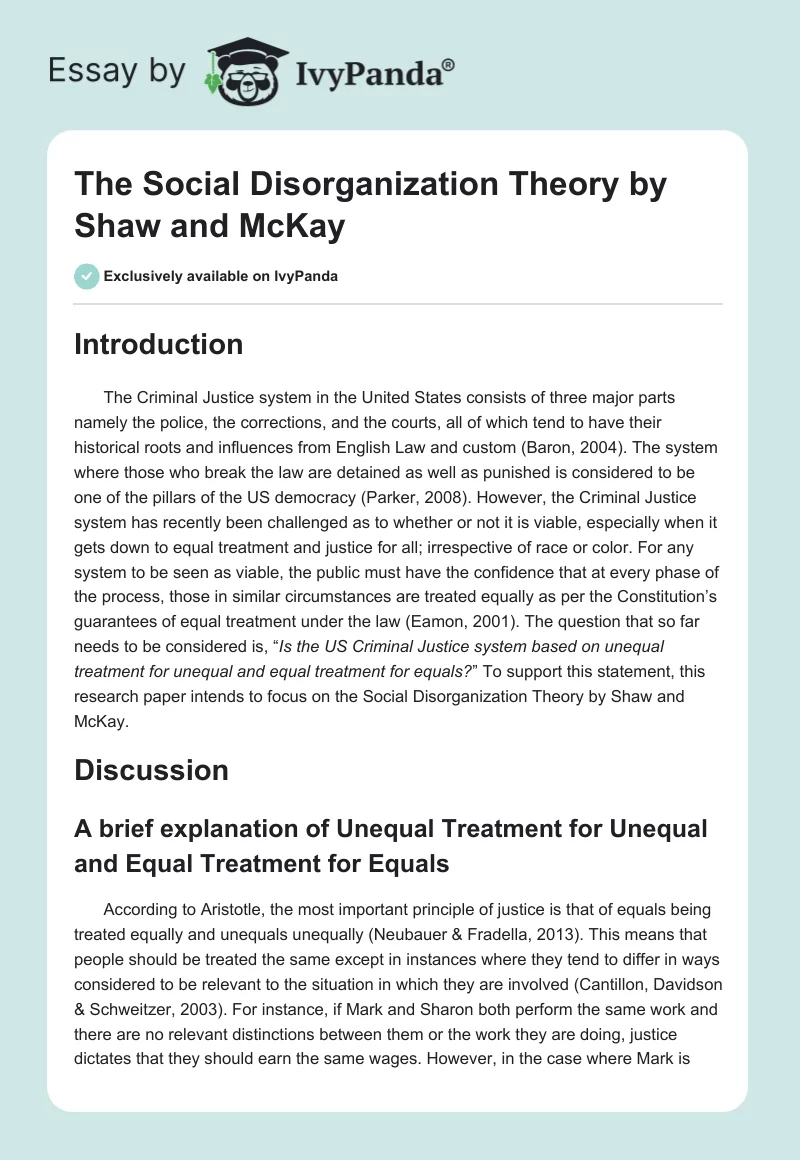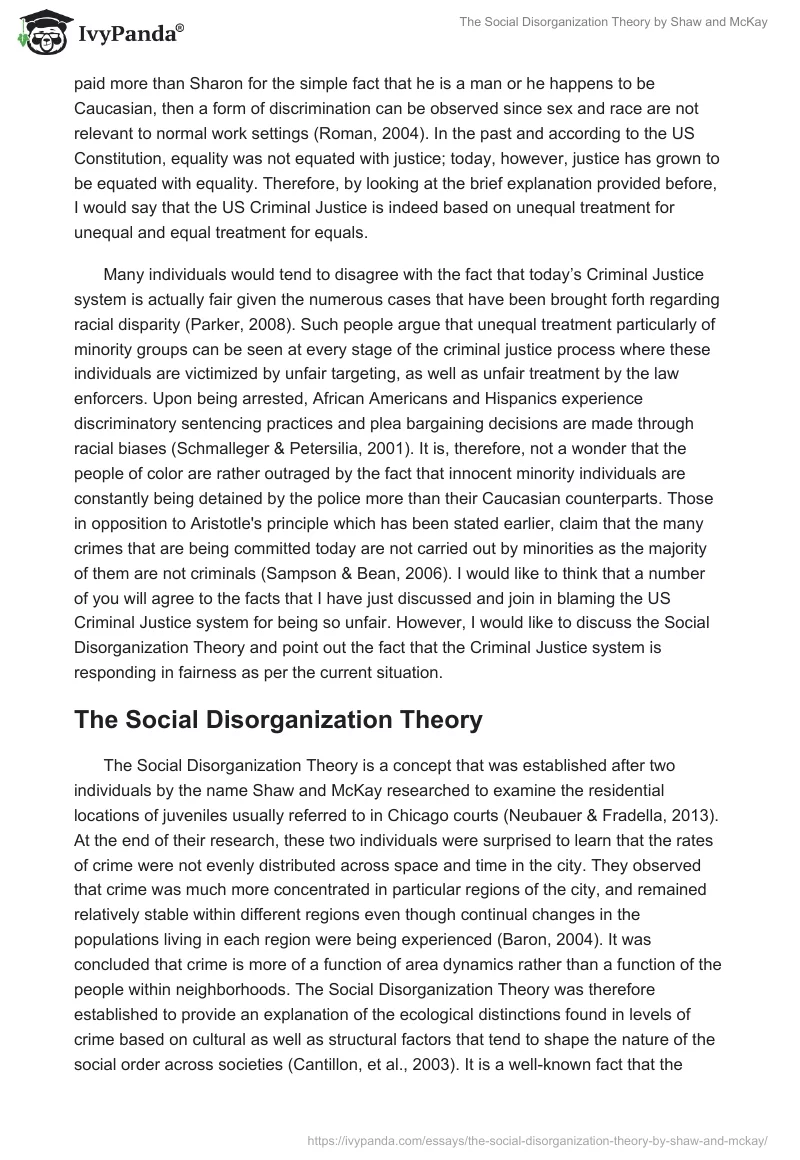Introduction
The Criminal Justice system in the United States consists of three major parts namely the police, the corrections, and the courts, all of which tend to have their historical roots and influences from English Law and custom (Baron, 2004). The system where those who break the law are detained as well as punished is considered to be one of the pillars of the US democracy (Parker, 2008).
However, the Criminal Justice system has recently been challenged as to whether or not it is viable, especially when it gets down to equal treatment and justice for all; irrespective of race or color. For any system to be seen as viable, the public must have the confidence that at every phase of the process, those in similar circumstances are treated equally as per the Constitution’s guarantees of equal treatment under the law (Eamon, 2001). The question that so far needs to be considered is, “Is the US Criminal Justice system based on unequal treatment for unequal and equal treatment for equals?” To support this statement, this research paper intends to focus on the Social Disorganization Theory by Shaw and McKay.
Discussion
A Brief Explanation of Unequal Treatment for Unequal and Equal Treatment for Equals
According to Aristotle, the most important principle of justice is that of equals being treated equally and unequals unequally (Neubauer & Fradella, 2013). This means that people should be treated the same except in instances where they tend to differ in ways considered to be relevant to the situation in which they are involved (Cantillon, Davidson & Schweitzer, 2003). For instance, if Mark and Sharon both perform the same work and there are no relevant distinctions between them or the work they are doing, justice dictates that they should earn the same wages.
However, in the case where Mark is paid more than Sharon for the simple fact that he is a man or he happens to be Caucasian, then a form of discrimination can be observed since sex and race are not relevant to normal work settings (Roman, 2004). In the past and according to the US Constitution, equality was not equated with justice; today, however, justice has grown to be equated with equality. Therefore, by looking at the brief explanation provided before, I would say that the US Criminal Justice is indeed based on unequal treatment for unequal and equal treatment for equals.
Many individuals would tend to disagree with the fact that today’s Criminal Justice system is actually fair given the numerous cases that have been brought forth regarding racial disparity (Parker, 2008). Such people argue that unequal treatment particularly of minority groups can be seen at every stage of the criminal justice process where these individuals are victimized by unfair targeting, as well as unfair treatment by the law enforcers. Upon being arrested, African Americans and Hispanics experience discriminatory sentencing practices and plea bargaining decisions are made through racial biases (Schmalleger & Petersilia, 2001).
It is, therefore, not a wonder that the people of color are rather outraged by the fact that innocent minority individuals are constantly being detained by the police more than their Caucasian counterparts. Those in opposition to Aristotle’s principle which has been stated earlier, claim that the many crimes that are being committed today are not carried out by minorities as the majority of them are not criminals (Sampson & Bean, 2006). I would like to think that a number of you will agree to the facts that I have just discussed and join in blaming the US Criminal Justice system for being so unfair. However, I would like to discuss the Social Disorganization Theory and point out the fact that the Criminal Justice system is responding in fairness as per the current situation.
The Social Disorganization Theory
The Social Disorganization Theory is a concept that was established after two individuals by the name Shaw and McKay researched to examine the residential locations of juveniles usually referred to in Chicago courts (Neubauer & Fradella, 2013). At the end of their research, these two individuals were surprised to learn that the rates of crime were not evenly distributed across space and time in the city. They observed that crime was much more concentrated in particular regions of the city, and remained relatively stable within different regions even though continual changes in the populations living in each region were being experienced (Baron, 2004). It was concluded that crime is more of a function of area dynamics rather than a function of the people within neighborhoods.
The Social Disorganization Theory was therefore established to provide an explanation of the ecological distinctions found in levels of crime based on cultural as well as structural factors that tend to shape the nature of the social order across societies (Cantillon, et al., 2003). It is a well-known fact that the majority of African Americans, as well as Hispanics residing in the United States, are low-class individuals who have part-time jobs and do not earn much. We also know that according to recent statistics regarding crime rates in most parts of America, the majority of those who have been arrested happen to be those from minority groups.
In the course of their research, Shaw and McKay also observed that apart from lack of behavioral regulation, neighborhoods considered to be socially disorganized tended to produce criminal norms that could be handed down to successive generations of youths (Eamon, 2001). Such a system of pro-delinquency attitudes could easily be passed on to the younger generations during their daily contact with older juveniles (Baron, 2004). This is why a neighborhood that is characterized by social disorganization is considered to be fertile ground for crime as well as delinquency (Roman, 2004). Cultural transmission of delinquent attitudes and values, as well as lack of behavioral control mechanisms, contribute to such situations.
Coming back to our current situation, the majority of African Americans and Hispanics reside in neighborhoods that are popular with gangs and another manner of vices. The youths in such neighborhoods tend to have most likely dropped out of school and engaged in crimes such as robbery with violence in order to earn a living (Krohn, Lizotte & Hall, 2010). You will find that most of the racial minority children and youths come from homes where one of the parents is absent, both parents are alcoholics or drug addicts or are not present to offer the required guidance to them. Racial minority neighborhoods are filled with individuals trying to earn a living in whichever way possible, irrespective of who gets hurt along the way.
It is true that out of those arrested for crimes, the majority happen to be from racial minority groups. The Social Disorganization Theory has indicated that neighborhoods having low socioeconomic status, family disruption, as well as racial heterogeneity, tends to also have unsupervised youths and low organizational participation (Parker, 2008). This in turn increased the rates of crime. Those in opposition to the initially stated principle of Aristotle need to note that the economic well-being of a given community usually determines the variation in the rates of delinquency.
As compared to white communities, African American as well as Hispanic communities are rather poor and lack adequate resources to defend their interests (Correla, 2000). Such a situation has resulted in suppressed hostility which is expressed through social disorganization. This is because those from the minority groups tend to feel frustration, alienation, resentment, and hopelessness especially when it concerns the Criminal Justice System (Schmalleger & Petersilia, 2001). These feelings are being expressed through the current crimes that are taking place in various parts of the United States. It is important to keep in mind that being poor, or of the lower class, does not necessarily entitle one to engage in crime or criminal activities. That is why the US Criminal Justice system is based on unequal treatment for unequal and equal treatment for equals.
Conclusion
Looking at what has been discussed above it is common for people to believe that the US Criminal Justice system is unfair and tends to racially discriminate individuals from minority groups. The media and some recent statistics have revealed that African Americans tend to be more vulnerable to police arrests as compared to their white counterparts. This has in turn created outrage by the minority groups, citing that the system should consider carrying out more investigations on their white counterparts as they too tend to commit crimes. Based on Aristotle’s principle, the US Criminal Justice is acting in accordance with what is just and fair, and the Social Disorganization Theory appropriately explains why African American individuals are arrested more than Caucasians.
References
Baron, S.W. (2004). General Strain, Street Youth and Crime: A Test of Agnew’s Revised Theory. Criminology, 42(2). Pp. 457 – 483.
Cantillon, D., Davidson, W.S., & Schweitzer, J.H. (2003). Measuring Community Social Disorganization: Sense of Community as a Mediator in Social Disorganization Theory. Journal of Criminal Justice, 31(4). Pp. 321 – 339.
Correla, M.E. (2000). Citizen Involvement: How Community Factors Affect Progressive Policing. Washington, D.C.: Police Executive Research Forum.
Eamon, M.K. (2001). Poverty, Parenting, Peer, and Neighborhood Influences on Young Adolescent Antisocial Behavior. Journal of Social Service Research, 28(1). Pp. 1 – 26.
Krohn, M.D., Lizotte, A.J., & Hall, G.P. (2010). Handbook on Crime and Deviance. New York: Springer.
Neubauer, D., & Fradella, H. (2013). America’s Courts and the Criminal Justice System. 11th Edition. New York: Cengage.
Parker, K.F. (2008). Unequal Crime Decline: Theorizing Race, Urban Inequality and Criminal Violence. New York: NYU Press.
Roman, C.G. (2004). Schools, Neighborhoods, and Violence: Crime Within the Daily Routines of Youth. Lexington, MA: Lexington Books.
Sampson, R.J., & Bean, L. (2006). Cultural Mechanisms and Killing Fields. In The Many Colors of Crime, by Ruth D. Peterson, Lauren J. Krivo, and John Hagan. New York: New York Univ. Press.
Schmalleger, F., & Petersilia, J. (2001). Criminal Justice Today: An Introduction Text for the Twenty-First Century. New Jersey: Prentice Hall.


